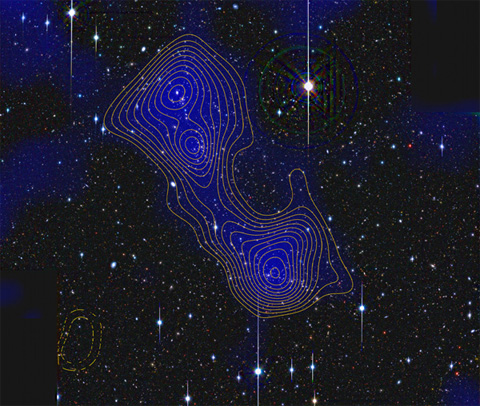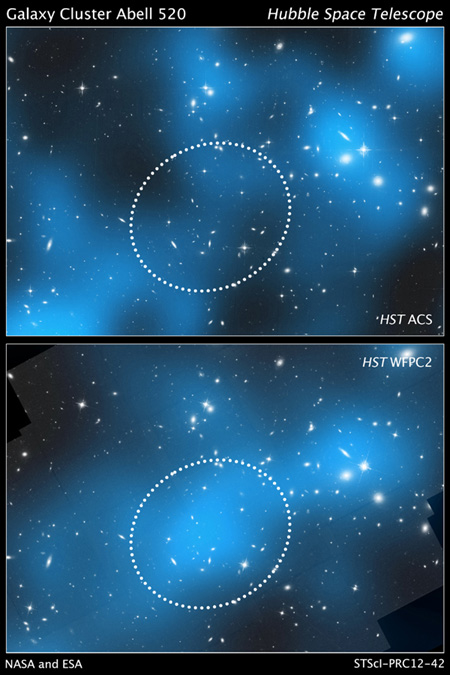
Dr. Douglas Clowe is an astrophysicist in the Department of Physics & Astronomy in the Ohio University College of Arts & Sciences.
By Stephanie Dutchen
From Perspectives
Peer through a telescope and you’ll see a night sky filled with galaxies, gas and dust clouds, planets, pulsars, black holes, and ever more beautiful and strange objects.
But this cosmic light show only reveals part of the picture. When you add the masses of all the objects we can see—everything that’s built from protons and neutrons and other “normal matter,” from our own bodies to the most distant proto-galaxies—it’s not enough to explain why the universe works the way scientists observe. Galaxies and galaxy clusters that should have spun apart are still somehow held together. Galaxies in clusters orbit one another faster than they ought to.
Since the problem became apparent in the 1930s, scientists have been investigating two possible solutions: Either gravity works differently on cosmic scales than it does in our solar system, or there’s about five times more invisible or “dark matter” out there exerting gravity than there is normal matter.
Evidence has convinced most researchers in the field that dark matter exists, even if they don’t yet know what it’s made of. In fact, they think it accounts for 22.5 percent of the universe, while normal matter only makes up 4.5 percent. (The other 73 percent appears to be a component called dark energy, which is pushing the universe apart despite dark matter’s gravitational pull.)
In 2006, Ohio University astrophysicist Dr. Douglas Clowe and colleagues helped clinch the argument for dark matter. Analyzing two galaxy clusters that recently collided, they showed that dark matter needs to exist even if the laws of gravity change. Today, Clowe continues to probe the mysteries of dark matter and dark energy to understand them better and learn more about the past and future of the universe.
That’s no small task, given that “we know almost nothing about dark matter aside from that it needs to be there,” he says.

Clowe and colleagues recently discovered that these two galaxy clusters, Abell 222 and Abell 223, are connected by a filament of dark matter. Image courtesy of Jorg Dietrich.
If You Can’t See It, Lens It
As an observational cosmologist interested in something that doesn’t emit or reflect light, Clowe wrestles with a constant challenge: trying to study something he can’t see.
The answer lies in measuring dark matter indirectly, using a phenomenon called gravitational lensing. This occurs when light from a distant object gets bent around a massive object as the light travels toward us. Studying the distortion reveals information about the mass of the middle object.
(Watch a video of Clowe explaining gravitational lensing.)
In lucky cases, there are clearly visible distortions such as arcs and duplicate images of the same galaxy. This strong lensing effect is like looking at a candle flame through the base of a wineglass.
Unfortunately, it’s much more common for the distortions to be too slight to be visible. Scientists including Clowe have been honing techniques to calculate this weak lensing by statistically analyzing hundreds or thousands of background objects together.
“It is a fiendishly difficult measurement, and it has taken people as determined as Doug a couple of decades to extract reliable observations from even the best modern telescopes,” says Richard Massey, a physicist at Durham University in England and one of Clowe’s collaborators.
A Silver Bullet
Clowe and colleagues made their breakthrough discovery while using a pair of galaxy clusters as their gravitational lens. They nicknamed it the Bullet Cluster because one cluster had shot through another at 1 percent of the speed of light, leaving a shock wave in its wake.
In that never-before-seen scenario, the gas clouds that typically make up about 90 percent of the normal matter in clusters had slammed into each other, while the individual galaxies, accounting for a mere 10 percent of the normal matter, had sailed through—the intergalactic equivalent of two convertibles smashing in a head-on collision while the occupants go flying past one another.
(Watch Neil DeGrasse Tyson and Clowe demonstrate this concept on NOVA scienceNow.)
Clowe and team used lensing to calculate the total mass and distribution of gravity in the cluster. When they mapped it onto the visible matter, they found that most of the Bullet Cluster’s total mass corresponded not with the majority of the visible mass in the gaseous center, but instead with the galaxies on the sides. That meant the dark matter hadn’t slowed down with the gas.
That gave scientists their clearest idea yet of how much dark matter particles interact with one another. (Answer: not very much.)
Clowe also realized that “this was the first time we could show that dark matter had to exist even if we could change gravity,” he says. “There’s really no way you can change gravity in a way that you could have all the mass be in one position and the center of gravity be somewhere else. It would be like the Sun suddenly having its center of gravity be off around Jupiter.”
Even with modifying gravity, says Clowe, the best you can say is that you only need twice as much dark matter as normal matter.
The Shot Heard ‘Round the World
Scientists and news media alike celebrated the findings. Discovery News named it one of the top ten discoveries of the decade. Clowe’s Bullet Cluster image was splashed across magazines and textbook covers. It even made a cameo appearance on the TV show The Big Bang Theory.
Clowe’s team had provided key information about dark matter, but science requires repeatability. As Massey says, “The Bullet Cluster is great—but it’s only one collision, which we see from only one angle, and which occurs over such a long period of time that we effectively see only one still frame from its video.”
Researchers throughout the field joined in the search for more colliding clusters. For seven of the eight they’ve found (and given nicknames like Baby Bullet and Musketball), lensing measurements have indicated similar separations of dark and normal matter and comparable results for dark matter’s interactivity.
The one source of dispute so far is Abell 520, also known as the Train Wreck Cluster because it’s a cosmic mess of not two but four colliding clusters.
A team led by astrophysicist Andisheh Mahdavi of San Francisco State University found the expected concentrations of dark matter around the clusters—plus one in the middle, where there didn’t seem to be any galaxies. The team offered several possible explanations for this “dark core,” but they were “almost equally unlikely” and unappealing, says Mahdavi.
Meanwhile, Clowe and colleagues performed their own observations and analyses using a different camera on the Hubble Space Telescope—and didn’t detect a dark core. “What we saw was perfectly consistent with the standard model of dark matter,” says Clowe.
The question isn’t settled yet. One of Mahdavi’s colleagues is examining Clowe’s latest results and expects to reach a different conclusion.
It’s not that one team or the other wants dark matter to behave in a particular way. Rather, the key lies in determining which lensing techniques are most accurate.
For now, Clowe is confident in his team’s findings. “Unfortunately,” he says, not only is there a limited number of colliding clusters in the universe to study, but “we can only measure dark matter gravitationally, so we still don’t know that much more about it.”

These composite images taken by two different teams using the Hubble Space Telescope show different results concerning the amount of dark matter in the core of the merging galaxy cluster Abell 520. Credit: (top) D. Clowe, (Ohio University, (bottom) J. Jee (University of California, Davis)
Strength in Partnerships
Scientists interested in dark matter would love to determine exactly what kind of particle it is and how it behaves. Astronomy can’t currently achieve that, but particle physics might.
Experiments are being conducted in detectors and accelerators around the world to try to catch a speck of dark matter. Physicists think they’ve narrowed it down to three candidates—the sterile neutrino, the neutralino, and the axion—all of them incredibly hard to detect because of their near-zero interaction with normal matter.
Plus, there’s the boost from building bigger and better telescopes. A major upcoming opportunity for dark matter and dark energy research is the Large Synoptic Survey Telescope, or LSST, an international endeavor. Clowe is a member of one of the science working groups.
Tentatively scheduled to begin full operations in Chile at the end of this decade, with its 3,200 megapixel camera the LSST promises to “give us images of half the sky down to depths where we can easily do gravitational lensing measurements,” says Clowe. “Instead of small numbers of colliding clusters, we’ll get hundreds. That will greatly help us understand what’s going on.”
Beyond Dark Matter
While the LSST gears up, Clowe keeps busy with an array of research projects. For example, he was part of a team that recently detected a filament of dark matter connecting two parts of a supercluster. This filament is part of a “skeleton” of dark matter threaded throughout the universe that had previously been predicted but not reliably observed.
Many of Clowe’s other investigations go beyond dark matter. He has assessed star formation in the Bullet Cluster, determined the properties of galaxies that formed in the very early universe and worked to calculate the redshifts of galaxies too faint to measure using the standard method of spectroscopy.
As the head of the imaging team for the European Southern Observatory Distant Cluster Survey, he studies the structural evolution of distant galaxy clusters and their components. Thanks to gravitational lensing effects, he also uses these clusters, including the Bullet Cluster, as magnifying glasses to learn about even more distant galaxies that are too faint to detect otherwise.
Then there is the dark energy question.
“Dark matter is one of the science bogeymen in that we don’t know exactly what it is. Well, for dark energy we don’t even have any good ideas,” says Clowe.
He wants to learn more about the nature of dark energy and gauge its behavior throughout the history of the universe by using gravitational lensing studies of very distant galaxy clusters.
He’s conducting what are called photometric redshift analyses on about 90 clusters to see if he can replicate the results of similar studies done using supernovae. His technique would provide another way of estimating the expansion rate of the universe—in other words, showing that dark energy exists—without relying on the underlying assumptions the supernova studies depend on. If it works, he plans to conduct a larger-scale study with data from the LSST.
The ultimate goal of his research and of cosmology in general, Clowe says, is to fully understand things like whether and how the universe began, how structures including the Milky Way formed and what will happen to everything in the end—if there is an end. Key to attaining that knowledge is being able to pin down the values of about 10 fundamental cosmological parameters, including the expansion rate.
Whatever else he is able to achieve during his career, “I find cosmology fascinating,” says Clowe. “We know so little about the universe. We’re just now making the discoveries that are going to be part of every elementary school textbook, the same way that Galileo and Newton and some of the early scientists are. We have the ability to work on something fundamentally new that no one has any idea about.”
This article appears in the Spring/Summer 2013 issue of Perspective magazine, which covers Ohio University research, scholarship and creative activity.



















Comments